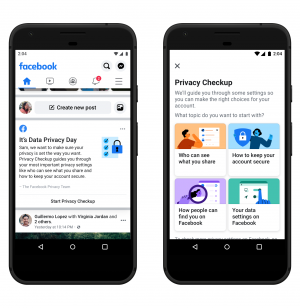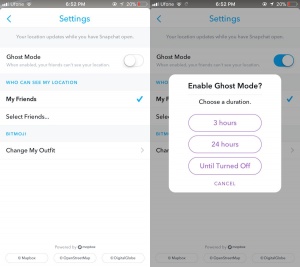Samantha Thick
The Age of Information is an exciting and terrifying era to live in. There are endless debates about individual’s privacy and the deregulation of privatized technology companies that control information flow. Some believe privacy is a luxury of the past and as the world becomes more digital, we must give it up, others believe tech companies are unrightfully using our information for their own benefit and we must fight for privacy. My personal data identity falls somewhere in between these two arguments. I believe in technological evolution and digitalizing the future to connect the world and make things more accessible. I also believe my information is mine and I should have the sole ability to decide what gets shared and who uses it.
Contents
My Data Identity: As Private As A Social Media User Can Be
I have taken the efforts necessary to implement my data identity into how I use social media and the internet to the best of my ability. From what I found in this project, I am happy with the results and how my public information represents me. Remaining private while also being active on public forums and social media is easier than many may think. To educate both sides of the privacy argument I will break down how I personalized my internet portfolio.
Social Media Privacy Settings
Before getting into what my online data identity looks like to the digital world, I wanted to break down the privacy settings I have on my social media platforms. As an active social media user I enjoy the information and interaction these platforms allow me to have but understand concerns people have with how they invade privacy. The biggest complaint I hear about these sites is that they are too public and share too much personal information with the world. As someone who was raised to keep as much personal information off the internet as possible but also raised in the age of a social media boom, I have been more aware of the privacy settings applications provide than most users my age.
Facebook is one of the most confrontational social media hosts coming largely from the fact that it was one of the first, has older generations as users, and has made many mistakes over the years. Facebook has also learned from its past flaws, to an extent, when it comes to improving user based privacy settings. Unknown to many of its users, be it because of age or lack of investigation, you can make your Facebook profile/page private.
By going to your profile and clicking on the "Profile Settings" tab, navigating to the "View Privacy Shortcuts" (I am using the terms and steps used in mobile application mode) you are presented with six different privacy categories. From here the user can change privacy settings whether it be how information is shared across the Facebook community(with Friends, Friends of Friends, Only Me, or Public), how Facebook shares your information with search engines and other of its affiliates, and how it interacts with your phone(Location sharing, linking with other application, etc.).
From my personal experience the biggest steps in securing my online identity was to change all of the default sharing options from "Public" to "Only My Friends", turning off location tracking (which by default is turned on), and most importantly turning off the ability for my profile to appear in search engine results. Now, the only way to find my Facebook profile is to be logged into Facebook and specifically type my exact Profile name into the search, or to look through the "Friends" list of those I have accepted as my "Friend".
Instagram, my personal favorite site, mostly because I enjoy images and looking through photos but also because of how easy it is to make a profile secure. Their private profile option gives the user total control over who sees what and when. By setting my profile to private I already limit the ability for anyone that I do not previously approve of from seeing anything more than my profile picture and my biography. Instagram offers many other more detailed privacy options as well allowing me to limit who sees which stories, messages, comments, tags, and activities.
All these settings are found in the "Settings" tab of the user profile under the "Privacy" section where you find privacy sections focused on "Account Privacy", "Interactions", and "Connections". Another important section to note is the "Security" section of the settings. Here you will find important settings on how Instagram itself uses your data. Under the "Data and History" section you have the ability to limit how your information is shared with other applications, websites, and ad companies. Another way I keep my data private with Instagram, and all of my social media sites, is by not allowing them to connect. By keeping each application separate and not connecting my profiles it is harder for the internet to connect the dots on my trends and personal information.
Twitter has also come a long way in its privacy settings from when it originated. Now, you can make accounts private and follow many of the same privacy settings I described in the Instagram section. One thing Twitter does remarkably well is make it easy to turn off personalized data tracking. This may seem surprising as many who have used the Twitter API know how easy it is to pull tweets but that is because many users do not take the time to turn off their sharing. Under the "Personalization and Data" section of their privacy settings Twitter has in depth explanations of what they are doing with your data and how they are sharing it but all you have to do is click the slider to turn these setting to "off". To keep my Twitter even more private than most, without effecting user experience, I do not connect my Twitter to my phone number or contact list. This is just another way of creating a barrier between all the different pieces of my online identity.
Snapchat
Snapchat also has different privacy settings and personalization settings available but they are harder to find. They make personal account information settings, like who can see what and when, obvious under the "Settings" tab but to get into details of how Snapchat uses your information and manage the way your Snap data is shared the path is less obvious. By navigating to the "Additional Services" --> "Manage" --> "Data Saver" you can then turn off different "Ad Preferences", "Lifestyle & Interests", "Map" sharing, and other security settings. Because of their poor labeling and confusing structure, I found their privacy settings to be the least user friendly.That being said, I allow Snapchat more access to information than other applications. I share my location (only while using the app), contact list, phone number, and camera roll. This comes from the nature of the application as less social media and more communication based. However, they are a social media host in all other accounts, especially concerning how they use and share personal user data. To retain privacy I turn off many settings, for example on "snap map" my location is in "ghost mode".
Did These Privacy Precautions Work?
After testing my online identity through Google Search Incognito Mode(avoiding saved settings in my normal chrome window) and fastpeoplesearch.com I was happily surprised with how little the internet knew about me. Almost all I found were professional profiles and images I purposely made public for the purposes of academia and job searches.
Google Search (Incognito Mode)
My Google exploration was done three times, each search more specific via location than the first. I began by searching my full name "Samantha Thick" and the results I got were 5/10 accurately linked to me. Of these five pages all were related to professional sites and profiles such as LinkedIn and Portfolium. The images in this search returned three of me, one my LinkedIn profile, the other two were near the bottom of the results and were from Newspaper articles about my high school basketball performances.
My next search limited the scope by adding "Ann Arbor Michigan" after my name. This search returned almost the same results the only difference being an image that linked me to my job with the University of Michigan.
Finally, I replaced the "Ann Arbor Michigan" with my hometown and state. I expected the most information to be found about me with this search, because I am from a small town, and had an successful athletic career in high school. This supposition was correct. Most of the images and articles were me and majority of them were articles reporting game statistics and breakdowns.
When searching as specific as full name and hometown some information is inevitable to be shared as my address, birthday, and other personal information is found through the Michigan resident database and voting records database.
Conclusion
In conclusion, I am proud of how I have managed to be an active social media user and keep my personal information private. I have managed to stay private while being social by using a diminutive form of my full name as my social media handles, changing my privacy settings, and turning off my data sharing. I still have work to do in limiting the amount I share with certain applications and companies but for now I agree with and support what the internet portrays as my Data Identity.

